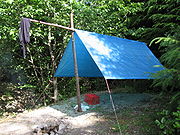
Fly (tent)
Encyclopedia

.svg.png)
- For other meanings, see Fly (disambiguation)Fly (disambiguation)A fly is any species of insect of the order Diptera; to fly is a verb referring to flight, the process of flying. Fly may also refer to:* Fly , a part of trousers or other garments...
A fly refers to the outer layer of a tent or to a piece of material which is strung up using rope
Rope
A rope is a length of fibres, twisted or braided together to improve strength for pulling and connecting. It has tensile strength but is too flexible to provide compressive strength...
as a minimalist, stand-alone shelter. In basic terms, a fly is a tent
Tent
A tent is a shelter consisting of sheets of fabric or other material draped over or attached to a frame of poles or attached to a supporting rope. While smaller tents may be free-standing or attached to the ground, large tents are usually anchored using guy ropes tied to stakes or tent pegs...
without walls. Purpose-made stand-alone flies are also sometimes referred to as bivouacs, bivvies, tarpaulin
Tarpaulin
A tarpaulin, colloquially tarp, is a large sheet of strong, flexible, water-resistant or waterproof material, often cloth such as canvas or polyester coated with urethane, or made of plastics such as polyethylene. In some places such as Australia, and in military slang, a tarp may be known as a...
s, or hootchies. Flies are generally used for keeping moisture (such as condensation or rain) or sun off people while they eat, rest or sleep. They can also be used as groundsheets
Tent
A tent is a shelter consisting of sheets of fabric or other material draped over or attached to a frame of poles or attached to a supporting rope. While smaller tents may be free-standing or attached to the ground, large tents are usually anchored using guy ropes tied to stakes or tent pegs...
, but this is not recommended since it creates wear and tear which can lead to holes.
A stand-alone fly is a multi-purpose tool and is very flexible. For example, a fly can be put up in a wide variety of shapes depending on the environment and the weather, whereas a tent usually has a pre-set configuration for its structure which can be adjusted somewhat but not substantially. A fly also has the advantage of being particularly light and portable.
Disadvantages of flies include that a person is still exposed to the elements such as mosquitoes and cold weather and that it can be difficult to put a fly up if there are limited natural vertical structures such as trees in the camping area. Flies, however, can be put up using poles or jury-rigged, for example, using paddles.
A fly is also used to create shade as in the desert. Then a traditional tent is erected under the fly.
See also
- Bivouac sackBivouac sackA bivouac sack is an extremely small, lightweight, waterproof shelter, and an alternative to traditional tent systems. It is used by climbers, mountaineers, hikers, ultralight backpackers, soldiers and minimalist campers...
- LoueLoue (tent)A loue is an ultra-light Finnish open tent used to give shelter from wind and rain during rest stops or over-night camping during hikes...

